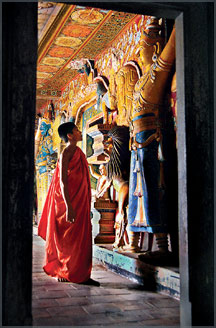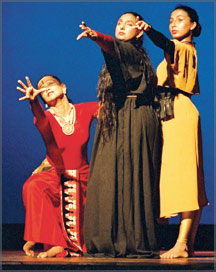Arts
Roots, Reflections & Reminiscences
Colourful reminiscences of a bygone era:
by Ranga Chandrarathne
Tissa Abeysekara's work titled Roots, Reflections & Reminiscences was
recently launched marking yet another important milestone in Tissa
Abeysekara's trail brazing career as bi-lingual author.
Perhaps, Tissa Abeysekara is the most famous contemporary bi-lingual
in Sri Lanka who is not from the academia. Although Martin
Wickremasinghe wrote in English, by his own admission, Wickremasinghe
had never been at ease with English and most of his English writings
were confined to articles on literature and anthropology.
|

L-R Jayantha Dhanapala,Gill Westeaway,Country Director,
British Council,Tissa Jayatilleke and Tissa Abeysekera.
Pic Palitha Gunasena |
However, singular characteristic of Tissa Abeysekara's writing in
both Sinhala and English is that he is able to express his heart and
mind in a most natural way, with diction unique to him. His diction in
English is more or less close to those of famous English essayists such
as Virginia Woolf and prose of Somerset Maugham.
Tissa Devendra in his introductory remarks at the launch stated that
... Tissa comes from a split social background. His father was from the
Anglicized upper middle class whilst his mother hails from an
exclusively Sinhalese speaking lower middle class with roots in rural
hinterlands of our country. Tissa is a fusion.
On occasions, an uncomfortable and an uneasy fusion of these two
strands. But Tissa has, like any gifted human being, is confusing in
social circumstances. He is one of the giants of that vanishing, if not
vanished, bi-lingual intelligentsia of our country.
Reggie Siriwardene, a literary giant had observed that in Tissa's
creative writing in English, the language of our colonial rulers, has
acquired, and for the first time, a distinctly Sri Lankan tone.
The book runs into 264 pages has been divided into three main
sections; Roots, Reflections and Reminiscences.
It contains articles by the author which had appeared in Newspapers
and numerous presentations that he made at diverse international fora in
addition to Tissa's reflections on diverse subjects ranging from cinema
to his life and times.
In the chapter "Fifty-Fifty of the Species" which is a presentation
the author read at the SAARC Writers Conference held in Lahore, Tissa
traces back to the very commencement of Sri Lankan writers in English
and of writers in English from SAARC countries.
Tissa Abeysekara states Thus we preened ourselves on our ability to
speak English properly and found the English spoken with Tamil accent,
cause for laughter. Those were the times when ethnicity had not yet
reared its poisonous hood, and both Sinhalese and Tamils laughed
together good-naturedly.
There was a man who wrote in English in the nineteenth century; he
was Sinhala, an official of rank in the Colonial administration, and his
name was Dandris de Silva Gooneratne.
He wrote an essay on Demonology to the Royal Asiatic Journal of 1868,
it immediately acquired seminal status. Lord Macaulay, read the essay,
and was impressed enough to write to Dandris de Silva personally. In the
letter, the imperial agent observed thus: Of all my imitators, writing
in English, you seem to have come closer to stimulating basic elements
of my style. Dandris Silva was immediately christened as "Ceylon
Macaulay".
Even though Ceylon had a writer who wrote as well as Macaulay as far
back as 1864, our first great candidate for serious critical attention
in the world of English creative writing, Michael Ondaatje emerged only
in the eighties.
Abeysekara also states that although Sri Lanka produced number of
outstanding scholars and scholarly writing in English, they all wrote
from the head and something was missing.
The problem was not one of learning the language, or mastering its
vocabulary, its grammar and its syntax. The challenge was to integrate
language into one's thinking. It is here that both Mulkraj Anand and
Bankim Chandra Chatterjee of India, and Lucian de Zylwa of Sri Lanka
failed.
Among the fascinating chapters in the section "Reminiscences" is the
chapter on Martin Wickremasinghe. It is here that Tissa Abeysekara
explains his quest in search of his roots and the vital role the
language plays in a culture.
More than his novels, reminiscence like Apey Gama, voyage of cultural
discovery like Kalu Nika Seveema, intellectual quest like, Sinhala
Lakuna, and awesome treatises like Sinhala Sahitayaye Negeema, conquered
me completely.
I was slowly discovering my roots, tracing the contours of my
fractured cultural heritage and learning a principle which continued to
guide me the importance of language in culture. It is generally accepted
that language is the most important and acceptacle conveyor of culture,
the code of solidarity among people who share a common past.
The book is a must read for deserving readers who cherish the
cultural baggage the bygone era bequeathed to us. It is also the
reflection of the contemporary cultural history of Sri Lanka where the
cultural scene was dominated by bi-linguals who nourished the vernacular
languages as well as the language of their adaptation that is invariably
the Colonial master's English language.
[email protected]
Nethra Pooja
A rare insight into monastic life:
by Indeewara Thilakarathne
The exhibition of photographs by Janaka Wettasinghe, explores
hitherto unseen aspect of monastic life in Sri Lanka. It is the aspect
of omni-present solitude and the renunciation of worldly belongings by
the meditating Buddhist monks that Wettasinghe has captured through his
artistic eye.

Janaka Wettasinghe is a Deputy Editor of Budusarana, perhaps the only
newspaper in Sinhala dedicated to the spread of the doctrine of the
Buddha. He travelled far and wide, sometimes on foot climbing steep
rocky terrains, into the very core of monasteries to capture
quintessence of monastic life in Theravada tradition of Buddhism.
Veteran photographer Lal Hagoda stated The cover picture should be
eye-catching and it should also be a correct report on the place of
worship or the environment. A significant aspect of Janaka's photography
is that he achieved both with the use of theory and the correct use of
intrinsic properties of the picture.
Most of Wettasinghe's pictures embody the solitude, calmness, the
simplistic and idealistic life the Buddhist monk lead in those
monasteries. It is a life in total conformity with nature, with bare
necessities.
On one occasion as Wettasinghe was not allowed in, to the monastery,
he took a snap of the lonely fleet of stone-slabbed steps leading to the
monastery through a dense forest, embodying the omni-present solitude
associated with the lives of monastic Buddhist monks.
In his fascinating journey into the untrodden territories,
Wettasinghe has taken a novel perspective in portraying some of the rare
glances into the order which spiritually nourishes the thousands of
Buddhist for centuries.
The exhibits included both famous and little know places of worship.
One of the significant aspects of Wettasinghe's photography is his
innate ability to capture details from entirely novel perspective.
[email protected]
Nirmana (Nava Narthana Prasangaya) and Beri Nada
Creations based on traditional dance forms:
by Ranga Chandrarathne
Nirmana and Beri Nada, concerts by veteran dancer Ravibandu
Vidyapathi will be held on August 25, 2007 and 26, 2007 at BMICH.

Especially the performance include Ravibandu's three novel creations;
two of them are a piece based on message issued by world famous artist,
Kazuo Aohno, one of the surviving Butoh dancers (Butoh, a Japanese
post-war dance movement and reflects on the consequences of war) and a
short message issued by eight-year old student of dance from France on
the International Dance Day.
For this unique piece, Ravibandu has used the third movement of
Padith Ravishankar's Sitar Concerto no 3. Another piece is based on a
message written by an eight year old student of dance from France on the
occasion of International Dance Day. One of the important pieces in this
performance is the piece based on Shakespeare's sonnet. It is a dance
trio.
The rest of the performance includes Ravibandu's previous creations
such as piece on Judas against classical music.
One of the highlights of the performance is ballet reflecting the
consequences of war through historical and contemporary characters of
mothers who lost their sons in the war; Kusumalatha, Ghandari and
Heccabi from Trojan Women. Music for the ballet is based on a score by
Eero Hamanimi.
A significant aspect of the performance is that though the pieces are
contemporary dances, the vocabulary of movements steps from traditional
Kandyan dance. Beri Nada show represents a range of drums of Sri Lankan
and other parts of the world.
The concert consists of pieces with local and modern drums and music
pieces such as Raga and classical tunes have also been added in order to
break the monotony.
[email protected]
|
